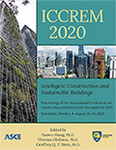International Conference on Construction and Real Estate Management 2020
Research on Influencing Factors of Construction Enterprise Social Responsibility Behavior Differences in Countries along the Belt and Road
Publication: ICCREM 2020: Intelligent Construction and Sustainable Buildings
ABSTRACT
China’s Belt and Road Initiative has brought broad development prospects to construction companies. The purpose of this study is to analyze the differences in social responsibility behaviors of construction enterprises under different institutional backgrounds along the Belt and Road countries based on institutional theory, and to find out the influencing factors of corporate social responsibility behavior differences at the national level. Through factor analysis and cluster analysis methods, third-party data is used to verify the countries along the Belt and Road. The research results confirm that the differences in social responsibility behavior of construction enterprises are influenced by political, economic, and social factors in different institutional contexts. The results can guide international construction enterprises to fulfill their social responsibilities more appropriately in the countries along the Belt and Road, as well as deepen the understanding of practitioners and the academic on the social responsibility of construction enterprises under different institutional backgrounds.
Get full access to this article
View all available purchase options and get full access to this chapter.
ACKNOWLEDGMENTS
This work was funded by the Humanities and Social Sciences Projects of Ministry of Education (No. 18YJA630113), the Humanities and Social Sciences Projects of Guangdong General Universities (No. 2017WTSCX097), and “University Innovation and Strong” Projects of Education Bureau of Guangdong Province (No. 2016WQNCX120).
REFERENCES
Amaeshi, K.M., Adi, A.B.C., Ogbechie, C. and Amao, O. (2006). “Corporate social responsibility in Nigeria: Western mimicry or indigenous influences?” Journal of Corporate Citizenship, (24), 83-99.
Beekun, R.I. and Badawi, J.A. (2005). “Balancing ethical responsibility among multiple organizational stakeholders: the Islamic perspective.” Journal of Business Ethics, 60(2), 131-145.
Campbell, J.L. (2007). “Why would corporations behave in socially responsible ways? an institutional theory of corporate social responsibility.” Academy of Management Review, 32(3), 946-967.
Carroll, A.B. (1991). “The Pyramid of Corporate Social Responsibility: Toward the Moral Management of Organizational Stakeholders.” Business Horizons 34(4), 39-48.
Fransen, L. (2013). “The embeddedness of responsible business practice: exploring the interaction between national-institutional environments and corporate social responsibility.” Journal of Business Ethics, 115(2), 213-227.
Gugler, P. and Shi, J.Y.J. (2009). “Corporate Social Responsibility for Developing Country Multinational Corporations: Lost War in Pertaining Global Competitiveness?” Journal of Business Ethics, 87(1), 3-24.
Gustavson, R. (2011). “Business ethics as field of teaching, training and research in oceania.” Journal of Business Ethics, 104(1), 63-72.
Han, L., Zeng, S., Ma, H. and Chen, H. (2015). “Does commitment to environmental self-regulation matter? an empirical examination from china.” Management Decision, 53(5), 932-956.
Helmstadter, G.C. (1964). Principles of psychological measurement, Appleton-Century-Crofts, New York.
Hofstede, G. (1980). Culture’s Consequences: International Differences in Work related Values, Sage, Beverly Hills, CA.
Jamali, D. (2014). “CSR in developing countries through an institutional lens.” Corporate Social Responsibility and Sustainability: Emerging Trends in Developing Economies. Emerald Group Publishing Limited, Emerald, 21-44.
Jones, M.T. (1999). “The institutional determinants of social responsibility.” Journal of Business Ethics, 20(2), 163-179.
Kemp, M., (2001). “Corporate social responsibility in Indonesia: Quixotic dream or confident expectation?, Technology.” Business and Society Programme Paper, (6).
Khanna, T., Kogan, J. and Palepu, K. (2006). “Globalization and similarities in corporate governance: a cross-country analysis.” Review of Economics and Statistics, 88(1), 69-90.
Lichtenstein, S., Badu, E., Owusu-Manu, D.G., Edwards, D. J. and Holt, G.D. (2013). “Corporate social responsibility architecture and project alignments: a study of the ghanaian construction industry.” Journal of Engineering Design and Technology, 11(3), 334-353.
Marquis, C., Glynn, M.A. and Davis, G.F. (2007). “Community Isomorphism and Corporate Social Action.” Academy of Management Review, 32(3), 925-945.
Matten, D. and Moon, J. (2008). “‘Implicit’ and ‘explicit’ CSR: A conceptual framework for a comparative understanding of corporate social responsibility.” Academy of Management Review, 33(2), 404-424.
Ringov, D. and Zollo M. (2007). “The impact of national culture on corporate social performance.” Corporate Governance: The international journal of business in society, 7(4), 476-485.
Robertson, D.C. (2009). “Corporate Social Responsibility and Different Stages of Economic Development: Singapore, Turkey, and Ethiopia.” Journal of Business Ethics, 88(4), 617-633.
Schmidheiny, S. (2006). “Turning Point: A View of Corporate Citizenship in Latin America.” Journal of Corporate Citizenship, (21), 21-24(4).
Scott, W.R. (2001). Institutions and organizations (2nd ed.). Thousand Oaks, CA: SAGE.
Seow, C. and Jamali, D. (2006). “Insights into triple bottom line integration from a learning organization perspective.” Business Process Management Journal, 12(6), 809-821.
Trompenaars, F. (1993). Riding the Waves of Culture: Understanding Cultural Diversity in Business, Nicholas Brealey Publishing, London.
Visser, W. (2006). Revisiting Carroll’s CSR pyramid: An African perspective, Copenhagen Business School Press, Copenhagen.
Visser, W. and Tolhurst, N. (2010). The world guide to CSR : a country-by-country analysis of corporate sustainability and responsibility. Sheffield, Greenleaf.
Wang, L. and Juslin, H. (2009). “The Impact of Chinese Culture on Corporate Social Responsibility: The Harmony Approach.” Journal of Business Ethics, 88(3), 433-451.
Ward and Joe, H. (1963). “Hierarchical grouping to optimize an objective function.” Journal of the American Statistical Association, 58(301), 236-244.
Whitley, R. (1999). Divergent capitalisms: The social structuring and change of business systems. Oxford University Press, Oxford.
Zeng, S.X., Ma, H.Y., Lin H. and Zeng, R.C. (2015). “Social responsibility of major infrastructure projects in China.” International Journal of Project Management, 33(3), 537-548.
Information & Authors
Information
Published In
ICCREM 2020: Intelligent Construction and Sustainable Buildings
Pages: 712 - 718
Editors: Yaowu Wang, Ph.D., Harbin Institute of Technology, Thomas Olofsson, Ph.D., Luleå University of Technology, and Geoffrey Q. P. Shen, Ph.D., Hong Kong Polytechnic University
ISBN (Online): 978-0-7844-8323-7
Copyright
© 2020 American Society of Civil Engineers.
History
Published online: Oct 14, 2020
Published in print: Oct 14, 2020
Authors
Metrics & Citations
Metrics
Citations
Download citation
If you have the appropriate software installed, you can download article citation data to the citation manager of your choice. Simply select your manager software from the list below and click Download.
